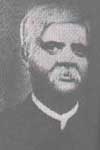This dispensary has a branch in the crowded part of the city, under the supervision of Dr. B.V. Maitra and I am glad to says greater number of patients were treated here. Dr. Maitra, moreover, deserves our best thanks, for here he used to supply al medicines himself. The dispensary is useful in other ways than giving medical help to the poor; the students of the Calcutta school of Homoeopathy have the opportunity of attending here, and of learning how to prescribe and take up a case.
Subsequently to the establishment of this institution, a very rich and respectable gentleman, Sir Rajah Saurindra Mohan Tagore, established under the direct supervision of Dr. P.C. Majumdar, a Homoeopathic dispensary in name and honor of his mother. There are two paid medical officers who prescribe and distribute medicines for the poor people gathered round them every morning. Deploring the neglect shown to Homoeopathy by our rich class of people in India, the medical officer says that our best thanks are due to the generous Raja (prince, as he is styled by our government), as he is the pioneer of giving public help to our cause.
The dispensary was established in July of 1891 and during this short period prospered greatly. During the year they treated ten thousand cases; the number of cures is very great. The Raja bears all the expenses which amount to about (150) one hundred and fifty rupees a month; Dr. Majumdar is an honorary superintendent. Here some of our students get their opportunity to learn clinical medicine.
The 15th of June, 1892, is especially memorable to us Homoeopaths in India, as on that day we established our Calcutta Homoeopaths Hospital. This is altogether a new feature in our country. It is entirely a charitable institution; all the patients are treated gratis. There are available spaces for (40) forty patients in the house where it is located now, besides a ward is set apart for receiving cholera patients.
It is under the charge of Dr. B.V. Chatterji. There is a managing committees consisting of all the teachers of our Homoeopathic school and many Homoeopathic physicians of the city; the secretary is Dr. P.C. Majumdar. On this hospital, though in its infancy, depends to a great measure the public recognition of Homoeopathy in our country. It is, up to date, supported by subscriptions among the Homoeopathic physicians of Calcutta. Our students get their clinical lectures here by the teachers.
There are about twenty Homoeopathic pharmacies in Calcutta for preparing and selling medicines and I am happy to say they are in a prosperous condition.
There are very few books published in India in English, but many in our own language. I give below the names of the authors and their books.
Dr. Sircar.-Treatment of Cholera; Materia Medica.
Dr. Salzer.-Lectures on Cholera; Periodicity of Drugs, Cirrhosis of Liver.
Dr. Bhaduri.-Translation of Baehr’s Science of Therapeutics, 2 vols. (Bengali); Treatment of Cholera (Bengali); Materia Medica (Bengali).
Dr. Majumdar.-Practice of Medicine, 2 vols. (Bengali); Materia Medica (Bengali); Translation of Bell’s Therapeutics of Diarrhoea, Dysentery, etc. (Bengali); Treatment of Cholera (Bengali); Hering’s Typhoid Fever (English); Epitome of Practice of Medicine (Bengali). .
Dr. Banerji.-Theory of Homoeopathy (Bengali).
Dr. Maitra.-Diseases of Children (Bengali); Treatment of Diarrhoea, etc. (Bengali).
The Homoeopathic Record is a journal published and edited by Dr. J.C. Lahiri regularly every month.
The Indian Homoeopathic Review now edited by P.C. Majumdar is an irregular visitor.
We have a Hahnemann Society in Calcutta. It meets every year to celebrate the anniversary of Hahnemann’s birthday on the 10th of April. Special meetings may be called when required.
Two or three days before my departure from Calcutta, there was a meeting of Homoeopathic physicians and students of our school to accord to me a farewell address. In that meeting one of our colleagues remarked that though our country was poor and dependent and we had nothing brilliant to offer to the members of the World’s Homoeopathic Congress and to our American Colleagues, yet we possess warm hearts and I believe Dr. Majumdar will be able to convey to them our warm and sincere greetings. Now, ladies and gentlemen, allow me to perform that pleasant duty of greetings you for myself and on behalf of my colleagues in India.
THE CHAIRMAN: Dr. Talbot, in this connection has a word to say from Dr. D.N. Banerjee, of Calcutta, India. He has received some communications, in the way of journals and otherwise for distribution, which can be obtained at the close of the session this morning. He is not here, so I will next call upon Dr. Fischer, of New South Wales.
DR. FISCHER, of Sidney: It is very little I have to say about our southern hemisphere of Australia, but I have prepared a few words which I will read to you.

